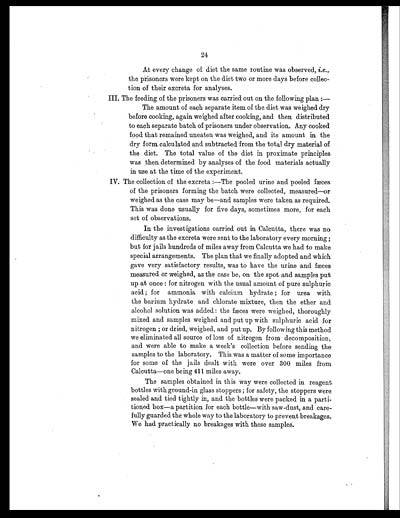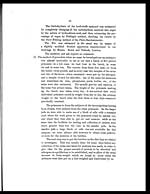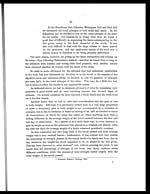Medicine - Institutions > Army health reports and medical documents > Scientific memoirs by officers of the Medical and Sanitary Departments of the Government of India > Number 37 - Investigations on Bengal jail dietaries > Front matter
(34) Page 24
Download files
Individual page:
Thumbnail gallery: Grid view | List view

24
At every change of diet the same routine was observed, i.e.,
the prisoners were kept on the diet two or more days before collec-
tion of their excreta for analyses.
III. The feeding of the prisoners was carried out on the following plan:—
The amount of each separate item of the diet was weighed dry
before cooking, again weighed after cooking, and then distributed
to each separate batch of prisoners under observation. Any cooked
food that remained uneaten was weighed, and its amount in the
dry form calculated and subtracted from the total dry material of
the diet. The total value of the diet in proximate principles.
was then determined by analyses of the food materials actually
in use at the time of the experiment.
IV. The collection of the excreta:—The pooled urine and pooled fæces
of the prisoners forming the batch were collected, measured—or
weighed as the case may be—and samples were taken as required.
This was done usually for five days, sometimes more, for each
set of observations.
In the investigations carried out in Calcutta, there was no
difficulty as the excreta were sent to the laboratory every morning;
but for jails hundreds of miles away from Calcutta we had to make
special arrangements. The plan that we finally adopted and which
gave very satisfactory results, was to have the urine and fæces.
measured or weighed, as the case be, on the spot and samples put
up at once: for nitrogen with the usual amount of pure sulphuric
acid; for ammonia with calcium hydrate; for urea with
the barium hydrate and chlorate mixture, then the ether and
alcohol solution was added: the fæces were weighed, thoroughly
mixed and samples weighed and put up with sulphuric acid for
nitrogen; or dried, weighed, and put up. By following this method
we eliminated all source of loss of nitrogen from decomposition,
and were able to make a week's collection before sending the
samples to the laboratory. This was a matter of some importance
for some of the jails dealt with were over 300 miles from
Calcutta—one being 411 miles away.
The samples obtained in this way were collected in reagent
bottles with ground-in glass stoppers; for safety, the stoppers were
sealed and tied tightly in, and the bottles were packed in a parti-
tioned box—a partition for each bottle—with saw-dust, and care-
fully guarded the whole way to the laboratory to prevent breakages.
We had practically no breakages with these samples.
Set display mode to: Large image | Zoom image | Transcription
Images and transcriptions on this page, including medium image downloads, may be used under the Creative Commons Attribution 4.0 International Licence unless otherwise stated. ![]()
| Permanent URL | https://digital.nls.uk/75032817 |
|---|




